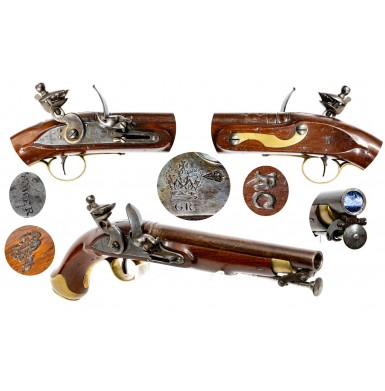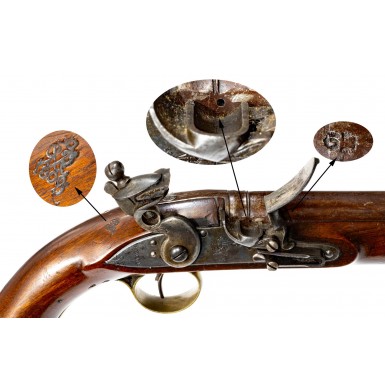British New Land Pattern Cavalry Pistol - Very Fine
- Product Code: FHG-2232-SOLD
- Availability: Out Of Stock
-
$1.00
1802 brought an end to the War of the French Revolution, a conflict that had raged from 1793-1802 and had embroiled much of Europe in conflict, with a coalition of forces such as Austria, Prussia, the Dutch Republic and Russia (among others) allied with the British against a the French Republic and their coalition of allies that included Denmark, Norway and Spain, among others as well. This period of intense, nearly global warfare had severely taxed the British military and the Board of Ordnance, particularly in the production and supply of small arms to the troops in the field. The system of simplification of arms patterns that had begun during the multiple British conflicts that had taken place during the period of the American Revolution had resulted in the adoption of the India Pattern (known to collectors as the 3rd Pattern) Brown Bess musket. These simplified arms were hardly as stylish and well-made as their Long and Short Land Pattern predecessors but were easier to produce in quantity and were robust, serviceable arms in the field. While infantry long arms had been semi-standardized based upon the India Pattern musket during the 1790s, the same could not be said of pistols.
Numerous patterns of pistols were in use among mounted troops, some designs in very small quantities based upon the designs of their colonels. The caliber of these guns was not completely standardized either. Some were “pistol bore”, nominally .56-.58 caliber (about 26 to 24 bore) and the rest were “carbine bore” nominally about .65 to .66 caliber (about 17 to 16 bore). This lack of uniformity in caliber alone raised the potential for ammunition supply issues in the field. One of the more common pistol patterns in use by the English as the War of the French Revolution came to a close was the Pattern 1793 Light Dragoon Pistol. A 10” barreled, carbine bore pistol that represented a transition from the earlier, more elegant patterns of the 1750s-1770s to the more utilitarian designs of the 19th century. These pistols saw service side by side with current production Eliott’s Light Dragoon pistols, Nock Inside Lock Pistols and a variety older pattern handguns and small run regimentally specific arms. The end of war with France in 1802 gave the Board of Ordnance the time to breath and to look towards the future as they redesigned the British cavalry pistol.
The result of the slightly more than one year of peace from the Treaty of Amiens on March 25, 1802 to Britain’s renewed declaration of war on France on May 18, 1803 was the New Land Pattern Pistol. The design was adopted just in time for the eruption of the War of the 3rd Coalition, which again pitted Great Britain and its allies against Napoleon’s France and their allies. The new design was standardized, simplified and no longer as graceful as its predecessors. The pistol had a 9” round, “carbine bore” smoothbore barrel that was retained by a single wedge in the forend and a screw through the breech plug tang. The pistol incorporated the flat, short-sear, post-1777 India Pattern pistol lock with a fenced pan and a flat, reinforced cock. The simplified walnut stock initially retained the basic carved apron around the breech plug tang, a feature that was soon eliminated, as were any significant moldings around the lock mortise. The simple brass furniture consisted of a lobed butt cap, a nose cap, a triggerguard and gripstrap reinforcement and a flat, geometric S-shaped sideplate. The pistol finally abandoned the loose wood or steel ramrods of earlier British military pistol designs and adopted a captive swivel ramrod that would be the bane of most British cavalrymen until the single shot pistol was removed from service. By about 1810, the pistol had evolved to include a stepped lock with a sliding safety to the rear of the hammer and a waterproof pan. Like most British military contractor provided arms, these evolutions took place over time with most of the guns featuring both improvements by the post-1810 period. By 1815 the browning of barrels was standard as well, but it was starting to appear by about 1808 on some guns. The very latest production period New Land Pattern Pistols produced from about the mid-1820s until the end of production introduced a lock that was rounded at the tail, finally leaving behind the pointed lock profile that date back well over 100 years. These flintlock cavalry pistols would be produced in large numbers during the Napoleonic Wars period and would remain in production until about 1835, when percussion ignition pistols would finally supersede the flintlock designs that had been in use for nearly 200 years. The New Land Pistol was not only used by the British military but by many of its allies during the Napoleonic Period, including the troops from Hanover and Portugal. By the end of the flintlock period, the British were also selling off obsolete New Land Pattern Pistols to many countries, including much of Latin America, Spain, Mecklenburg and Lubeck.
This example of a British New Land Pattern Cavalry Pistol is in VERY FINE condition. The gun remains 100% complete, correct and original and remains in fine original flint configuration. The gun was probably made circa 1805-1810 and includes the waterproof pan that was standard by about 1810 but does not incorporate the safety that was also standard from about 1810 on. The stock is the simplified example without the raise “beaver tail” shaped apron around the breech plug tang. The pistol’s barrel is browned, a finish that was not regularly encountered prior to about 1815, but that was incorporated on some of the earlier production pistols. The color casehardened lock has not been polished to bright, as they were with the pistols finished bright and is an attractive complement to the browned barrel. The early production period lock is pointed at the tail and features light, simple foliate engraving at the tail and on the hammer neck below the reinforcement. The tail of the lock is marked TOWER in a vertical arc and with the usual George III period {CROWN}/GR and with a small {CROWN}-{BROAD ARROW} beneath the pan. The lock has a {CROWN}/3 inspection on the interior, along with the contractor initials FW. This is almost certainly the mark of London contractor Francis Whitehead who had a contract from December 1801 to 1808 to provide locks to the Board of Ordnance. The firm of Whitehead & Son had an additional contract for Ordnance locks from August 1806-February 1818. The lower edge of the lock has the file slash mating mark \\\ |||, which is also found on the bottom of the barrel beneath the touchhole and on the necks of the breech plug tang and lock mounting screws. The lock mortise is marked with a large X in pencil and similar X is scratched into the bottom of the barrel between the wedge tenon and the ramrod swivel mount. This mates the barrel to the stock. The presence of two sets of mating marks that mate sub-sections of a pistol is not uncommon during this period. The breech of the barrel is clearly marked with British military proofs, consisting of a {CROWN}/GR/{BROAD ARROW} and a {CROWN}/{CROSSED SCEPTERS}. A small {CROWN} inspection is present at the rear of the breech plug tang and on the rear face of the breech plug. The touchhole is marked with a {CROWN}/6 inspection, the bottom of the barrel with a {CROWN}/2 inspection and the ramrod with a {CROWN}/1inspection. Illegible inspection marks are present in the ramrod channel and on the lower right side of the grip, above the triggerguard. These are illegible due to being stamped deeply into the wood, making the marks unclear. The right wrist of the pistol is stamped with a {CROWN}/GR/1800 storekeeper’s mark. As I have noted before, the storekeeper stamps appear to have remained in service for a number of years after their manufacture, as I have seen guns with a storekeeper’s stamp with a date that was clearly as much as a decade prior to the manufacture of the gun it was applied to. The block letter inspection RC is present on the counterpane, opposite the lock. All of these markings, with the exception of the couple noted above, remain very clear, sharp and completely legible.
As noted, the pistol remains in VERY FINE condition. The 9” barrel retains about 90% of the original browned finish, with some thinning as well as some minor loss from scuffing and light wear. The lock retains much of the dully mottled bluish-gray case coloring with some hints of color and patterning. The lock remains very crisp and is mechanically excellent, functioning perfectly on all positions. The .65 caliber smooth bore of the pistol remains in about FINEcondition as well. It is partly bright with scattered patches of darker surface oxidation and some minor roughness mixed with some lightly scattered pitting. A good cleaning with a bronze brush would likely improve the bore to nearly excellent condition. The original swivel ramrod is in place and functions exactly as it should. The reverse of the rod with the threaded female socket for the attachment of cleaning implements fits the stock channel very tightly and requires some effort to pull the rod from the stock. The brass furniture has an attractive, mellow mustard patina and is very attractive. The stock of the pistol remains very crisp and sharp with fine lines and edges. The stock shows absolutely no signs of being sanded and is solid and full-length. The stock is free of any breaks or significant repairs, although there is a tiny grain crack in the bottom of the forend, running about 1” from the ramrod entry back towards the triggerguard. This is very tight and barely noticeable under normal light but is mentioned for exactness. It in no way detracts from the displayability of the pistol. The stock does show a small number of lightly scattered bumps, dings and marks from handling and use, but absolutely no abuse or unusual wear and tear.
Overall this is an extremely crisp and very attractive example of a British New Land Pattern Cavalry Pistol that was produced circa 1808 and retains most of its very attractive period finish. The pistol is in a wonderful state of preservation, is completely correct and is well marked throughout. It would be a wonderful addition to any advanced collection Napoleonic arms and will certainly look wonderful in such a display.
SOLD
Tags: British, New, Land, Pattern, Cavalry, Pistol, Very, Fine










